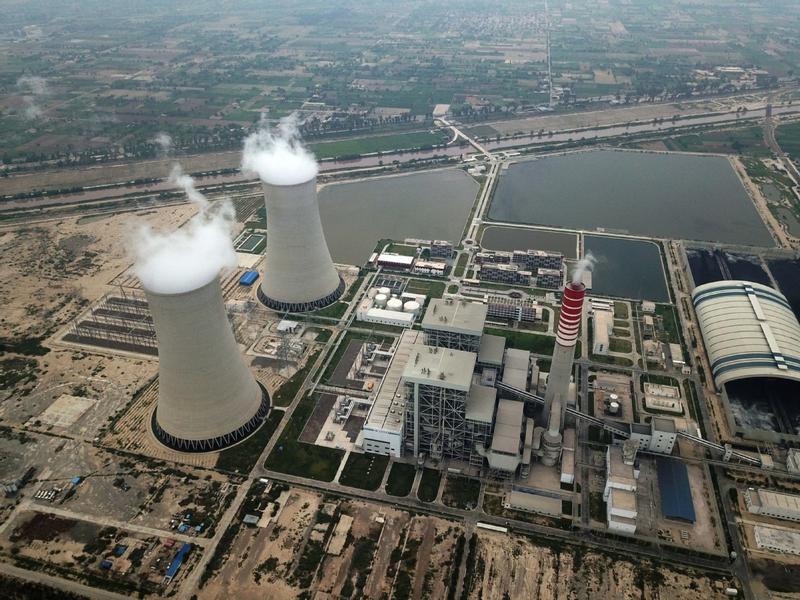 The aerial photo taken on Aug 6, 2019 shows the Sahiwal Coal Power plant in Sahiwal, Punjab province, Pakistan. (AHMAD KAMAL / XINHUA)
The aerial photo taken on Aug 6, 2019 shows the Sahiwal Coal Power plant in Sahiwal, Punjab province, Pakistan. (AHMAD KAMAL / XINHUA)
ISLAMABAD-During the COVID-19 pandemic in 2020, electricity generated by China-Pakistan Economic Corridor (CPEC) energy projects accounted for about one-third of Pakistan's power supply, according to the Chinese embassy in Pakistan.
Liu Binxiang, a 36-year-old Chinese engineer working in Pakistan's Sahiwal coal-fired power plant, is one of the thousands of staff who contributed to the achievement.
Liu began working at the plant in 2015 when the major energy project under the CPEC launched construction. He originally planned to return to China for a vacation in February, 2020. However, his plan was stymied by the sudden outbreak of COVID-19.
"Normally, Chinese staff of our power plant can go back to China every three months while I had to spend a major part of last year working in the plant due to the suspension of flight services and other adverse effects of COVID-19," said Liu, deputy director of the operation department at the facility.
The pandemic disrupted the normal rotation of staff and the purchase and transport of production materials, causing the power plant problems such as a lack of manpower and spare parts. The depleted power plant staff were placed under great stress.
Amanullah Khan, Chairman of Pakistan-China Business and Investment Promotion Council, said when the COVID-19 lockdown was eased in Pakistan, almost all sectors recovered quickly because China-Pakistan Economic Corridor (CPEC) energy projects have been actively and efficiently producing a big chunk of Pakistan's total energy supply
"For many of the 900 staff working in different capacities, they had to take on the workload of two people. But it is something we have to do, because our primary responsibility is to generate electricity to meet the energy requirements of Pakistan's economic and social activities," Liu said.
Sharing this sense of responsibility, Pakistani employees of the Sahiwal plant, located in the country's eastern Punjab region, also made sacrifices for a common goal.
ALSO READ: China, Pakistan 'resolute' in promoting CPEC construction
"I went home in September after working at the power plant for six months, and came back in October. Before the pandemic, I used to go home every weekend," said Ehtisham Tanvir, an engineer from Lahore, provincial capital of Punjab.
To prevent and control COVID-19, staff at the Sahiwal plant reacted rapidly and implemented closed-off management on March 1, days after the first cases were reported in Pakistan, which prevented Pakistani staff from going home whenever they were off-duty like in pre-contagion days.
Before he returned to his post after vacation, Tanvir had both PCR and antibody tests thrice and was quarantined for 14 days at the power plant. Thanks to its strict COVID-19 prevention measures including wearing masks and disinfections on a daily basis, the Sahiwal plant has so far seen no infections.
"Considering the special circumstances amid COVID-19 and the critical nature of our job, the strict anti-epidemic measures enforced by our power plant were the only way to deal with this," the 27-yearold who joined the power plant shortly after graduation in 2015 told Xinhua.
As a Pakistani who had experienced blackouts of over 12 hours every day, Tanvir has a deep understanding of the importance of electricity. "CPEC energy projects including Sahiwal have made load shedding a relic of the past in Pakistan. Our country needs electricity. Our power plant has been trying hard to ensure a continuous supply of electricity to the grid, people and industry of Pakistan."
Tanvir said that he really appreciated the spirit of many of his Chinese colleagues who had to stay in the power plant over one year. "They (Chinese staff) have made a lot of sacrifices, and it requires a lot of mental strength to work in such difficult situations in a foreign land. I believe we are doing this because we all consider this our job, and our duty," he said.
After finally getting the chance to return to China for a vacation in August, Liu hurried to come back to Sahiwal, trying to ease the burden of his colleagues. Later this month, he will celebrate his fifth Spring Festival, the most important time for family reunions for Chinese, in Pakistan.
"I will surely miss my family members, especially my two kids, during Spring Festival, but they all support what I am doing. I also feel very proud of myself for being a part of CPEC and bringing tangible positive changes for our Pakistani brothers and sisters," Liu said.
With the joint efforts of both the Chinese and Pakistani employees, the Chinese-built power plant with two 660-megawatt supercritical units, generated some 6.5 billion kWh of electricity in 2020 alone, and produced over 29.1 billion kWh of electricity since it was put into commercial operation in 2017.
Besides the Sahiwal plant, all other CPEC projects also strove to overcome challenges posed by the pandemic to allow their construction and operations to basically remain normal. Chairman of Pak-China Business and Investment Promotion Council Amanullah Khan told Xinhua that after the pandemic gripped Pakistan, CPEC energy projects appeared as a major support for Pakistan's economic and social activities.
When the COVID-19 lockdown was eased in Pakistan, almost all sectors of business, trade and industries started working quickly, and the reason behind this is that CPEC energy projects have been actively and efficiently producing a big chunk of Pakistan's total energy supply, Khan said.
READ MORE: Pakistan receives China-donated vaccines
"Now, even though the pandemic is still there, CPEC energy projects are playing a vital role in helping Pakistan's industries run at full speed," Khan added.


